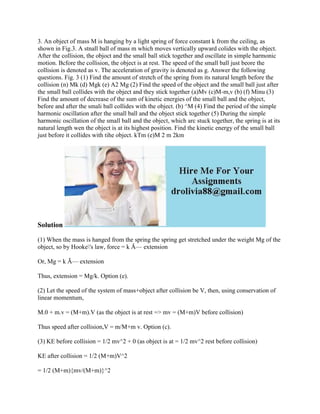3- An object of mass M is hanging by a light spring of force constant.docx
3. An object of mass M is hanging by a light spring of force constant k from the ceiling, as shown in Fig.3. A stnall ball of mass m which moves vertically upward colides with the object. After the collision, the objoct and the small ball stick together and oscillate in simple harmonic motion. Bcfore the collision, the object is at rest. The speed of the small ball just beore the collision is denoted as v. The acceleration of gravity is denoted as g. Answer the following questions. Fig. 3 (1) Find the amount of stretch of the spring from its natural length before the collision (n) Mk (d) Mgk (e) A2 Mg (2) Find the speed of the object and the small ball just after the small ball collides with the object and they stick together (a)Mv (c)M-m,v (b) (f) Minu (3) Find the amount of decrease of the sum of kinetic energies of the small ball and the object, before and after the smali ball collides with the object. (b) ^M (4) Find the period of the simple harmonic oscillation after the small ball and the object stick together (5) During the simple harmonic oscillation of the small ball and the object, which arc stuck together, the spring is at its natural length wen the object is at its highest position. Find the kinetic energy of the small ball just before it collides with tihe object. kTm (e)M 2 m 2km Solution (1) When the mass is hanged from the spring the spring get stretched under the weight Mg of the object, so by Hooke\'s law, force = k × extension Or, Mg = k × extension Thus, extension = Mg/k. Option (e). (2) Let the speed of the system of mass+object after collision be V, then, using conservation of linear momentum, M.0 + m.v = (M+m).V (as the object is at rest => mv = (M+m)V before collision) Thus speed after collision,V = m/M+m v. Option (c). (3) KE before collision = 1/2 mv^2 + 0 (as object is at = 1/2 mv^2 rest before collision) KE after collision = 1/2 (M+m)V^2 = 1/2 (M+m){mv/(M+m)}^2 = 1/2 m^2v^2/M+m Decrease of KE = 1/2 mv^2 - 1/2 m^2v^2/M+m = 1/2 mv^2 [1 - m/M+m] = 1/2 Mm/M+m.v^2 , Option (d). .

Recomendados
Recomendados
Más contenido relacionado
Similar a 3- An object of mass M is hanging by a light spring of force constant.docx
Similar a 3- An object of mass M is hanging by a light spring of force constant.docx (20)
Más de todd621
Más de todd621 (9)
Último
Último (20)
3- An object of mass M is hanging by a light spring of force constant.docx
- 1. 3. An object of mass M is hanging by a light spring of force constant k from the ceiling, as shown in Fig.3. A stnall ball of mass m which moves vertically upward colides with the object. After the collision, the objoct and the small ball stick together and oscillate in simple harmonic motion. Bcfore the collision, the object is at rest. The speed of the small ball just beore the collision is denoted as v. The acceleration of gravity is denoted as g. Answer the following questions. Fig. 3 (1) Find the amount of stretch of the spring from its natural length before the collision (n) Mk (d) Mgk (e) A2 Mg (2) Find the speed of the object and the small ball just after the small ball collides with the object and they stick together (a)Mv (c)M-m,v (b) (f) Minu (3) Find the amount of decrease of the sum of kinetic energies of the small ball and the object, before and after the smali ball collides with the object. (b) ^M (4) Find the period of the simple harmonic oscillation after the small ball and the object stick together (5) During the simple harmonic oscillation of the small ball and the object, which arc stuck together, the spring is at its natural length wen the object is at its highest position. Find the kinetic energy of the small ball just before it collides with tihe object. kTm (e)M 2 m 2km Solution (1) When the mass is hanged from the spring the spring get stretched under the weight Mg of the object, so by Hooke's law, force = k × extension Or, Mg = k × extension Thus, extension = Mg/k. Option (e). (2) Let the speed of the system of mass+object after collision be V, then, using conservation of linear momentum, M.0 + m.v = (M+m).V (as the object is at rest => mv = (M+m)V before collision) Thus speed after collision,V = m/M+m v. Option (c). (3) KE before collision = 1/2 mv^2 + 0 (as object is at = 1/2 mv^2 rest before collision) KE after collision = 1/2 (M+m)V^2 = 1/2 (M+m){mv/(M+m)}^2
- 2. = 1/2 m^2v^2/M+m Decrease of KE = 1/2 mv^2 - 1/2 m^2v^2/M+m = 1/2 mv^2 [1 - m/M+m] = 1/2 Mm/M+m.v^2 , Option (d).